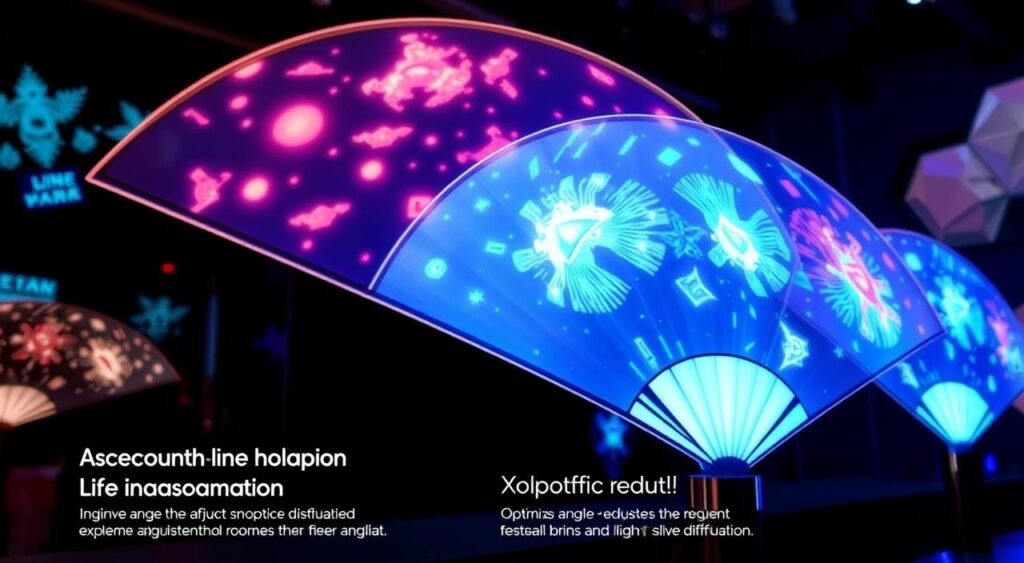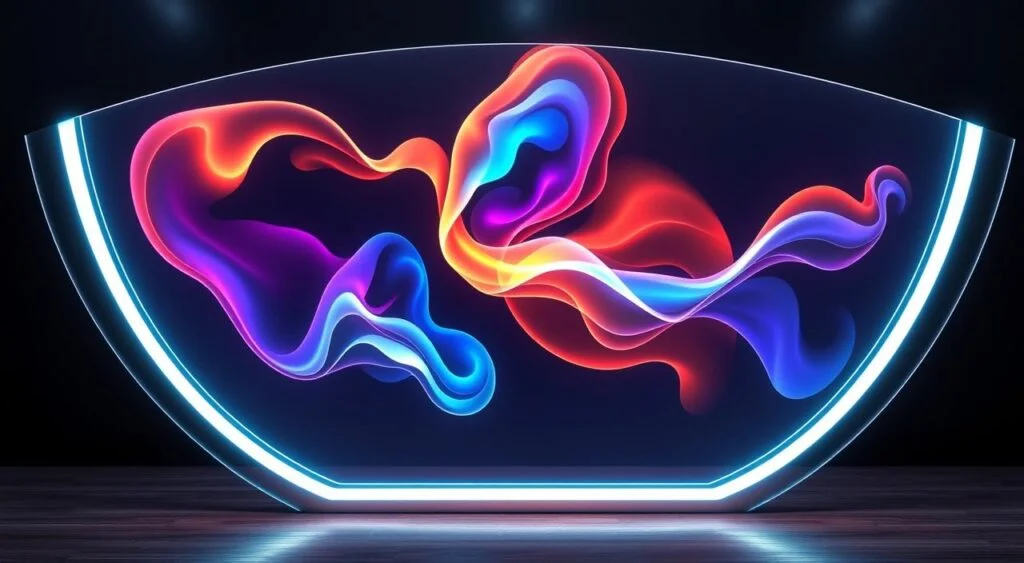To get the best results, it’s key to know how to reduce lines in hologram fan displays. These lines can come from things like a mismatch in frame rate, low-quality LED lights, and the environment1. Knowing what causes these lines is the first step to fixing them and making your hologram fan displays look better. By using tips to reduce hologram fan lines, you can make sure your projections look professional.
Hologram fans work by showing 3D images at a high frame rate. To avoid flickering or lines, it’s important to match the frame rate with the fan speed1. The right fan speed is critical; if it’s not set correctly, you might see jagged images or flickering lines1.
It’s also important to think about the environment around your hologram fan. Things like the lighting and background color can make lines more visible1. Adjusting the brightness to match the lighting can make your images clearer, as 80% of users have found2.
Key Takeaways
- Understanding the causes of lines in hologram fan displays is key to reducing them and improving quality.
- Setting the fan speed right and matching the frame rate is important for fewer lines.
- Things like lighting and background color can affect how lines are seen in hologram fan displays.
- Changing brightness to match the lighting can make images clearer.
- Using tips to minimize lines in hologram fan displays can help your projections look professional.
- Keeping the fan clean can also improve quality by stopping dust from affecting it1.
- Using high-resolution content can make your visuals better, as 85% of users agree2.
Understanding Lines in Hologram Fan Displays
To get rid of lines on hologram fans, we need to know why they happen. Issues like frame rate mismatch, low-quality LED lights, and environmental factors can cause them3. Lines can make the display look bad, like it’s distorted or not professional. Knowing the types of lines, like horizontal or vertical, helps us fix them and make our displays better.
Using a dark background can make 3D holographic displays clearer3. High-resolution images make the hologram look better3. Fast processing speeds help images change smoothly, which is good for the viewer3. Keeping the hologram fan in good shape is important for it to last long3.
Research shows that 3D holograms grab attention better than regular ads4. Events with 3D holographic tech leave a strong impression, like at trade shows4. People who see 3D holographic displays remember more than those who see regular displays4.
Common Causes of Line Formation
- Frame rate mismatch
- Low-quality LED lights
- Environmental factors
Impact on Display Quality
Lines on hologram fan displays can make the image look bad, like it’s distorted or not professional3.
Types of Lines You May Encounter
Horizontal or vertical lines are common on hologram fan displays. Knowing about these can help us fix them and improve the display quality3.
Essential Equipment and Software Requirements

To reduce lines in hologram fan displays, you need the right tools and software. This includes a top-notch hologram fan with dense LED light strips and a brushless motor5. For managing holograms, you can use programs like HoloStudio, Arway, Looking Glass Factory, Volumetric, and RealityEngine6.
Some important tips for cutting down lines on 3D hologram fans are:
- Use high-density LED light strips for better display quality
- Try hologram fan line reduction techniques, like adjusting frame rate and brightness6
- Choose software that lets you fine-tune display settings7
Keeping your holographic fans in good shape is key for a long-lasting display. Not doing so can make the device last shorter6. By getting the right equipment and software, and following maintenance and display tips, you can cut down lines on your 3D hologram fan. This will help you get a top-notch display.
How to Minimize Lines in Hologram Fan Technology
To reduce lines in hologram fan displays, consider hologram fan line reduction tips. Adjust the frame rate and use high-quality LEDs1. This boosts clarity and cuts down flickering. Also, reducing lines in hologram fan displays can be done by fine-tuning fan speed and content format8.
For hologram fan line smoothing strategies, keep these in mind:
- Optimize display settings like brightness and contrast for better image quality1
- Match the fan’s frame rate with its rotation speed8
- Choose high-quality LED lights to lessen visual distortions1
By using these methods, users can lessen lines in their hologram fan displays. This makes for a more engaging and immersive experience9. Regular upkeep, like cleaning the fan and updating firmware, keeps the display clear and working well over time8.
| Display Setting | Optimal Value |
|---|---|
| Brightness | 50-70% |
| Contrast | 40-60% |
| Frame Rate | 30-60 FPS |
Troubleshooting Common Line Issues

Fix lines in hologram fan displays, it’s key to finding and solving common problems. Look at hardware issues like broken LED lights or motors that need fixing or swapping10. Also, software problems like wrong frame rate or resolution can be fixed by tweaking settings10.
Understanding the cause of the problem is vital. Check the display settings and hardware to fix the issue. For example, adjusting the frame rate can help reduce lines. Real-time 3D holography might also help with eye strain during long VR sessions10.
Hardware-Related Problems
Issues with hardware can stem from faulty parts. Finding and fixing the problem is essential. Common problems include:
- Faulty LED lights
- Malfunctioning motors
- Incorrectly configured display settings
Fixing these issues can make the display better and reduce lines. The tensor holography system works much faster than old methods10. This means quicker troubleshooting and fixes.
Software Configuration Issues
Software problems can also affect hologram fan displays. It’s important to know how to adjust settings. Common issues include:
- Incorrect frame rate settings
- Incorrect resolution settings
- Incorrect display calibration
Fixing these problems can improve the display and reduce lines. A guide for fixing hologram fan issues is available online11.
Conclusion: Achieving the Perfect Hologram Display
Making the perfect hologram display is all about the details. It’s about getting rid of distracting lines and making the visuals better. This way, we can give our audience an experience they’ll never forget12.
Whether it’s for a product showcase, educational content, or an event, a top-notch hologram fan display makes a big difference. It leaves a lasting impression and helps us reach our goals.
To get the best out of hologram technology, we need to tweak a few things. Adjusting the spinning speed13 and fine-tuning the resolution and content format12 are key. Using the latest in photopolymer materials and spatial multiplexing helps us achieve amazing contrast, spatial resolution, and visual quality12.
This leads to a dynamic, high-definition experience that grabs the senses. It leaves a lasting impact on our viewers.
As we keep improving hologram technology, the possibilities are endless. By keeping up with trends, trying new things, and focusing on quality and reliability, we can take the hologram fan experience to new levels. We can captivate audiences like never before.
FAQ
What are the common causes of line formation in hologram fan displays?
Common causes include a mismatch in frame rate, low-quality LED lights and environmental factors.
How do lines impact the quality of hologram fan displays?
Lines can greatly affect the quality, causing a distorted or unprofessional look. This is a big issue for places needing top-notch visuals.
What types of lines may you encounter in hologram fan displays?
You might see horizontal or vertical lines. These can ruin the visual experience.
What equipment and software are essential for minimizing lines in hologram fan displays?
You need high-quality hardware like a hologram fan with dense LED lights and a brushless motor. Also, software for adjusting settings like frame rate and brightness is key.
How can you optimize settings to minimize lines in hologram fan displays?
To reduce lines, adjust settings like speed, resolution, and content format. Also, keep up with maintenance like cleaning and firmware updates.
How can you troubleshoot common line issues in hologram fan displays?
To fix common line issues, check for hardware problems like bad LED lights or motors. Also, look at software settings like frame rate and resolution.
Source Links
- How To Minimize Lines In Hologram Fan: 5 Powerful Tips – https://ntdesigns.com.au/technology/how-to-minimize-lines-in-hologram-fan/
- Easy Ways to Set Up Your Holofex Hologram Fan – https://holofex.com/blogs/news/ways-set-up-holofex-hologram-fan?srsltid=AfmBOopOJE5Q6MrjBQNXS0ULLRIB-fkU-C3oFdZxAvRucz0SCdH8iRa-
- How to Use a 3D Hologram Fan: 5 Steps That Guarantee Results – https://luminafans.com/blogs/hologram-blog/how-to-use-a-3d-hologram-fan?srsltid=AfmBOorekI_7tyFW-oqua1SrAzjnh_n4c1BxnlmT_9T8JH_cHaPC0dlP
- The Complete Guide to 3D Holographic Technology – https://luminafans.com/blogs/hologram-blog/3d-holographic-technology?srsltid=AfmBOoqdRoUgVxp-fsajxvPwlk-nw7a1AxoJ9tfihXczRc4MMl7a1Vss
- Holographic Fan: The Ultimate Guide for 2024 – https://luminafans.com/blogs/hologram-blog/holographic-fan-ultimate-guide?srsltid=AfmBOorLn-FzhjSRc1EE0qjhXsxU5mYbJzkmSltMPExffJnYNnId3O_E
- Holographic Fan Installation: 11 Easy Steps – https://luminafans.com/blogs/hologram-blog/fan-installation?srsltid=AfmBOop8Ya4AH8kHOJpSwySOmQ1XR3mfijP_MH8i4mej6QsmyZJQ4qZO
- The Ultimate Hologram Fan Buying Checklist – https://opsmatters.com/posts/ultimate-hologram-fan-buying-checklist
- How to Use a 3D Hologram Fan: 5 Steps That Guarantee Results – https://luminafans.com/blogs/hologram-blog/how-to-use-a-3d-hologram-fan?srsltid=AfmBOooidj7-2sXHvTvxG-0wTSUfCp60DA5rgatjyQS7pTwSu0x2HqnI
- The Complete Guide to 3D Holographic Technology – https://luminafans.com/blogs/hologram-blog/3d-holographic-technology?srsltid=AfmBOorJjup7oOMwmrtkXUnXMPFP1fzTUIITV5wWljYNkV5tt4UmiDbs
- Using artificial intelligence to generate 3D holograms in real-time – https://news.mit.edu/2021/3d-holograms-vr-0310
- Optical imaging applied to microelectronic chip-to-chip interconnections – https://opg.optica.org/ao/abstract.cfm?uri=ao-24-17-2851
- An ultrahigh-fidelity 3D holographic display using scattering to homogenize the angular spectrum – https://pmc.ncbi.nlm.nih.gov/articles/PMC10569707/
- How to Use a 3D Hologram Fan: 5 Steps That Guarantee Results – https://luminafans.com/blogs/hologram-blog/how-to-use-a-3d-hologram-fan?srsltid=AfmBOoqaX2BzkT4DuCCO8DqHGnaMQIyYgPQPwnpQmLsZO9Uu__fw5mxT
